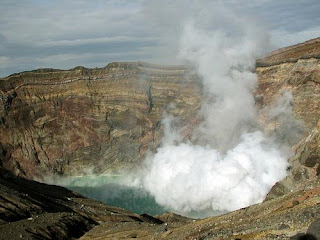Japan is well known for earthquakes but not so much for volcanoes. The first country that comes to my mind when I think of volcanic activity is Iceland, particularly after one of its unpronounceable volcanoes stopped most European air transport in 2010. However, there certainly are active volcanoes in Japan. You just have to venture to the most southern of Japan’s main islands, Kyushu, to see them.
Kyushu is home to the three most famous active volcanoes in Japan: Sakurajima, Shinmoedake and Aso-san. The Japanese word for volcano is kazan (火山) which literally means “fire mountain.”
Sakurajima
Sakurajima (literally “cherry island”) is a huge volcano only a few kilometres away from the major city of Kagoshima. Sakurajima is permanently active, erupting on a daily basis. It has been this way for decades and for that reason is of great interest to scientists.
Depending on the wind direction, ash from Sakurajima will rain down on Kagoshima. There is ash everywhere in the city: on cars, footpaths etc. The people of Kagoshima are quite comfortable with all of this. Apparently they check the wind direction before hanging their clothes outside to dry and will walk around with umbrellas if an ash shower is forecast.
Sakurajima is clearly visible from Kagoshima (because it’s so huge!) and very pretty at sunrise and sunset. When I was taking some photos of it at sunrise, it erupted throwing a large cloud of ash into the air. Here is a sequence of photos I took as well as a photo of Sakurajima as seen from Kagoshima on a clear day.
Shinmoedake
Shinmoedake (literally “new burning peak”) is about two-hours drive north of Kagoshima. Shinmoedake made international headlines when it violently erupted on 26 January 2011 causing evacuations from the local area. At one stage, a lightning storm passed through the ash cloud creating some spectacular images
When I visited Kyushu, it had fallen silent. Here are some news photo from the eruption in January 2011.
Aso-san
Aso-san is about three-to-four-hours drive from Kagoshima. It is a popular tourist destination due to the beauty and tranquillity of the surrounding landscape. Most visitors walk to the edge of the crater to look down at the bubbling lake within. Aso-san doesn’t emit ash and smoke like most volcanoes but rather belches out steam and sulphur dioxide. When a significant emission of sulphur dioxide occurs, a warning is sounded and everyone has to leave the area. That occurred when I visited. The gas definitely makes you cough!
As it was very cloudy on the day I visited Aso-san, I couldn’t take any decent photos of the crater. Here is a promotional photo of the crater on a clearer day.
The sleeping giant
The most famous volcano in Japan isn’t in Kyushu. In fact, it’s only 100km from Tokyo: Mt Fuji. Mt Fuji hasn’t erupted since 1707 and is considered dormant. If it was planning an eruption, now would be a good time since (i) nobody is on the mountain due to the Winter weather and (ii) the views of Mt Fuji from Tokyo are best in Winter. Last time it erupted, some ash rained down on Tokyo, but that’s just a normal day if you live in Kagoshima! I could handle that. Besides, I would get a great view of the eruption from my balcony!
Thank you for reading and take care.
Our Man in Japan.





No comments:
Post a Comment